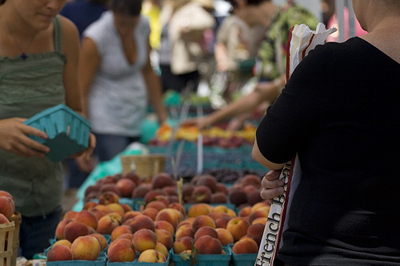How does buying local food help the Chesapeake Bay?
 Welcome to the latest installment of the BayBlog Question of the Week! Each week, we take a question submitted on the Chesapeake Bay Program website or a frequently asked question and answer it here for all to read.
Welcome to the latest installment of the BayBlog Question of the Week! Each week, we take a question submitted on the Chesapeake Bay Program website or a frequently asked question and answer it here for all to read.
This week’s question is: “In light of recent consumer buying trends, is there any evidence of environmental impacts in the Chesapeake Bay watershed of buying local foods? In other words, how does buying local food help the Chesapeake Bay?”
This is a great question, especially in relation to Maryland’s Buy Local Week, held from July 17-25 this year. Buy Local Week was initiated a few years ago by the Southern Maryland Agricultural Development Commission to raise awareness about the benefits of local food and community agriculture. It has since turned into a statewide initiative.
One of the major environmental benefits of incorporating local food into your diet is reducing the distance food is transported from where it is produced to where it is consumed. According to a 2001 report by the Capital Area Food Bank, fresh produce arriving at the Jessup, Maryland Terminal Market in 1997 traveled an average one-way distance of 1,686 miles from the state of production to Maryland.
The pollution associated with this transportation adds a considerable amount of nutrients to all water bodies, including the Chesapeake Bay and its tributaries. About one-quarter of the nitrogen pollution in the Bay comes from air pollution, so buying food produced locally is a great way to cut down on emissions.
Another way buying local food helps the Bay is by supporting and preserving local farms. When you buy local food, more of the money you spend goes directly to the farmer that grew it. Local, independent farmers can be vulnerable to development pressure, so supporting them helps them keep their farms going. Conversion of farmland to homes and shopping centers can adversely affect the long-term sustainability of the local farming industry, a significant part of the culture, heritage and economy of the Chesapeake region.
It seems that many people in Maryland already understand the importance of preserving farmland, as 61 percent of Marylanders surveyed by the University of Baltimore’s Schaefer Center for Public Policy said the issue was very important. Likewise, 78 percent of respondents said they were more likely to buy products identified as having been grown by a Maryland farmer.
So even after Maryland’s Buy Local Week is over, make an effort to shop at your nearest farmer’s market and begin incorporating local foods into your meals regularly. You can help to preserve a rich agricultural tradition, limit pollution to the Chesapeake Bay and its tributaries, support your local economy, and eat fresh, healthy food.
To find your local farmer’s market, check out the following sites:
- Maryland: http://www.mda.state.md.us/md_products/farmers_market_dir.php
- Virginia: http://www.vdacs.virginia.gov/vagrown/index.shtml
- Pennsylvania: http://www.buylocalpa.org/
- West Virginia: http://www.wvfarmers.org/
- New York: http://www.nyfarmersmarket.com/
- Delaware: http://dda.delaware.gov/marketing/DE_FRMVENS.shtml
- District of Columbia: http://www.freshfarmmarkets.org/
Do you have a question about the Chesapeake Bay? Ask us and we might choose your question for the next Question of the Week! You can also ask us a question via Twitter by sending a reply to @chesbayprogram! Be sure to follow us there for all the latest in Bay news and events!

Comments
There are no comments.
Thank you!
Your comment has been received. Before it can be published, the comment will be reviewed by our team to ensure it adheres with our rules of engagement.
Back to recent stories